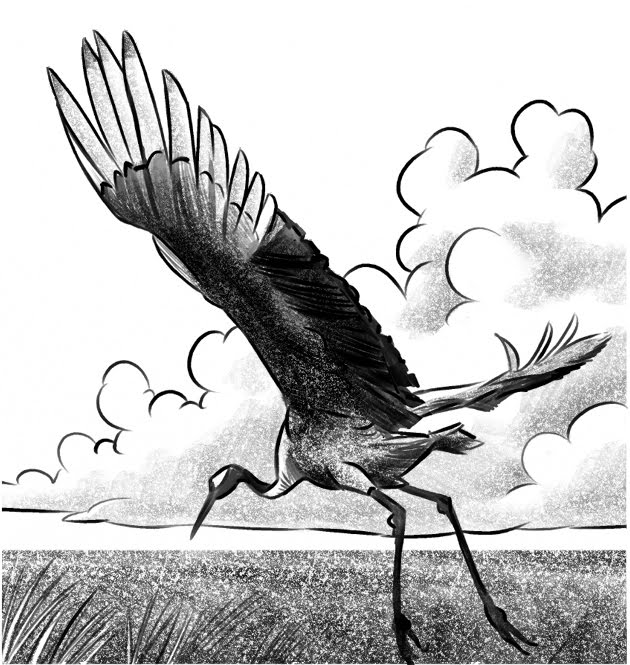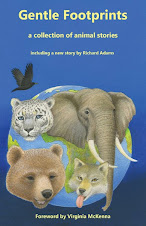Animal Anthology To Raise Funds for Born Free
This book is the annual charity book for Born Free...if you want to get involved with promoting and selling this book- email me!
www.bridgehousepublishing.co.uk

Sunday 13 February 2011
Almost 1000 books sold...
It has been a great experience working on this collection and we hope people will still post and tell us about what you're up to and tell us your animal stories.
Gentle Footprints has also spawned a new publishing venture with the Born Free Foundation- exciting stuff.
To find out more follow the link:
Monday 6 December 2010
aye aye

With its huge eyes and ears and its elongated fingers, this weird and wonderful lemur is without doubt the world’s most unusual primate. Long persecuted in its native Madagascar as an omen of death and evil, the aye-aye, like most of its lemur relatives, faces imminent extinction because of the added pressure of deforestation. This elusive species is the largest nocturnal primate and is the island’s answer to the woodpecker, as its specially adapted, flexible and skeletal third finger is used to find nutritious grubs and winkle them out from their woody burrows, in much the same way as a woodpecker’s beak.
Fast Facts
Type: Mammal
Diet: Omnivore
Average life span in captivity: 20 years
Size: Head and body, 14 to 17 in (36 to 43 cm); Tail, 22 to 24 in (56 to 61 cm)
Weight: 4 lbs (2 kg)
Protection status: Threatened
Did you know? Aye-ayes are the only primates thought to use echolocation to find prey.
Aye-ayes can be found only on the island of Madagascar. These rare animals may not look like primates at first glance, but they are related to chimpanzees, apes, and humans.
Aye-ayes are dark brown or black and are distinguished by a bushy tail that is larger than their body. They also feature big eyes, slender fingers, and large, sensitive ears. Aye-ayes have pointed claws on all their fingers and toes except for their opposable big toes, which enable them to dangle from branches.
The Aye-aye is classically considered 'solitary', but recent research suggests that they are more social than once thought. It usually sticks to foraging in its own personal home range, or territory. The home ranges of males often overlap and the males can be very social with each other. Female home ranges never overlap, though a male's home range often overlaps that of several females. The male Aye-Aye live in large areas that are up to 80 acres (320,000 m2) while female have smaller living space that goes up to 20 acres (81,000 m2). Regular scent marking with their cheeks and neck is a way that aye-ayes let others know of their presence and repel intruders from their territory.Like many other prosimians, the female Aye-aye is dominant to the male. The Aye-aye is not monogamous by any means, and often competes with each other for mates. Males are very aggressive in this regard, and sometimes even pull other males off a female during mating. Outside of mating, males and females interact only occasionally, usually while foraging.
The father will sometimes share food with the infant, but otherwise infants' primary source of social interaction is with their mothers. Mothers and infants often wrestle, chase, and play "peek-a-boo" for entertainment. After 13 weeks, infants are usually ready to interact with other young Aye-ayes, usually by play-fighting.
Cute baby
Efforts are being made to conserve these endangered animals, and the Durrell Jersey trust is working with the Madagascar Fauna group to facilitate this by methods which include habitat conservation as well as education of local people.
Monday 22 November 2010
A is for Aardvark


Blue Anteater & Cyril Sneer
My second thought was – “hang on, Cyril Sneer and the blue thing in the Pink Panther are anteaters not aardvarks.” This then led to the embarrassing realization that I didn’t actually know the difference between and aardvark and an anteater but guess what I found out…they are actually the same thing...sometimes! Some people actually call aardvarks "anteaters" and it is an accepted form of their name however the anteater is not actually related to the aardvark at all. In fact it even lives on a different Continent being an inhabitant of South and Central America. Confused yet?. Aardvarks are also called antbears, anteaters and earthpigs.
So with that misunderstanding cleared up (in a not very satisfactory fashion) my journey of anty discovery began.


An Aardvark Vs An Anteater - which is which??? (hint: the aardvark has bigger ears)
Aardvarks are found in sub-saharan Africa and are pig-like creatures. I bet you can’t guess what they eat. Oh you can – oh well. In that case I feel less clever telling you that they eat ants and small insects. I can recapture a bit of my cleverness, however, by revealing that the greedy things can suck up over 50,000 small bugs every time they eat. They do this with their long snout and tongues.
Aardvarks have powerful spoon shaped claws and can dig a hole very quickly. They use this skill to create their burrows. They have four toes on their front feet and five on their back feet.
Aardvarks gestate for 7 months and give birth to one baby which usually stays with it’s mother until it is of breeding age itself. Aardvarks in captivity live for around 24 years.
The aardvark's main predators are lions, leopards, hunting dogs and pythons. They also need to watch out for humans as some tribes use their heart, skin, foreheads and claws to create a powder which is worn as a charm to give the owner the ability to pass through walls or roofs at night.
The aardvark’s closest living relatives are (at opposite ends of the scale) the elephant shrew and the elephant.
Saturday 20 November 2010
The Mongoose
•Some species of the mongoose class are nocturnal while others come out in the light of day. One of the species known as yellow mongoose belong to the latter group and live a community life unlike the Egyptian mongoose, which lives a solitary life.

•Mongooses live in crevices of rocks and burrows. The interesting thing is that seldom do they dig these holes themselves, most of the time they just move into burrows that have been left by other animals.
•Scent plays a very important role in case of demarcating the territories of various species and they also use it to mark the reproductive status. They have a large anal scent gland for the same purpose.
•Apart from the scent they also make a high-pitched noise, which is termed as "giggling" as a sign of mating. Giggling is a form courtship when the animal is choosing a partner.
•The Mongoose is a very fast animal and in a conflict with a snake, it can dodge the snake and save itself from the strike of the snake easily. It uses several tricks and then when the snake is tired it attacks the snake and catches it by the back of its neck. It breaks the snake’s spine and eats the snake! Quite a feat for such a small animal. Humans are such scaredy cats really!

•They have a great tolerance towards the venom of the snake,but there have been times when the mongoose has eaten the head and the fangs, the latter pierce through the walls of the blood vessels in the body of the mongoose. The venom leaks into the bloodstream leading to the death of the animal.

•Some species of mongooses use various defense mechanisms to save themselves from the bigger carnivores. Like Meerkats of them acts as the guard who keeps a watch on the surroundings and makes a loud noise that works like an alarm call for the others. Once the other mongooses hear this alarm call they rush to the nearest hole as soon as they can.
There is very little difference between mongooses and meerkats but scientifically whilst a meerkat is a mongoose a mongoose is not a meerkat. Any differences are probably reflected in small cranial structures such as the auditory bulla (a small bone in the ear) and possibly dental characteristics.
The mongoose in literature was made famous by Rudyard Kipling's Rikki Tikki Tavi. This story was about a mongoose who saved an Indian family from a dangerous Cobra.


Hope you have enjoyed this brief look at this fascinating and brave little animal!
Monday 15 November 2010
Axolotl: the salamander that will never grow up

Axolotls have four different colourings, varying shades of brown with spots (wildtype), black (melanoid), pink with black eyes (leucistic) or golden or pink with pink eyes (albino). On average they grow to around 20cm long and can range in length from 15 to 45cm. Axolotls are native to Lake Xochimilco and Lake Chalco in Mexico. Lake Chalco was drained to avoid flooding and Lake Xochimilco is now not so much a lake as a series of canals, which supplies the 18 million people in Mexico City. The diminishment of their natural habit, reductions in water quality as well as being food (Axolotls were a staple food in the Aztec diet and axolotl eggs are eaten by carp and tilapia fish), has meant they are now critically endangered. Recent surveys have suggested that between 700 to 1200 axolotls survive in six locations within the Xochimilco area. Reintroduction of axolotls is not thought to be a good idea because of the risks of chyrdiomicosis, a disease caused by the chytrid fungus which is often fatal for axolotls. However, there are programmes to create wild refuges for axolotls in their native Mexico.
Although there are no stories featuring axolotls in “Gentle Footprints”, Julio Cortazar (1914 – 1984) published an axolotl-themed short story in in 1956 which was included in his “Final Deljuego” (End of the Game and other stories). In the story, a man frequently visits a zoo and finding his favourite animals, the lions and panthers, asleep (typical behaviour for big cats), he decides to explore the aquarium and finds himself entranced by the axolotls. He makes many return visits, comparing them to figurines of milky glass with discs of gold for eyes. The narrator goes from being transfixed to being transformed, looking at himself from inside the aquarium.

Tuesday 9 November 2010
The misunderstood Vampire Bat
To put it in context, though, that's only one or two teaspoonsful a night or every other night because they're only three inches long. Or looked at another way, the contents of the veins of a cow every four years. They have razor sharp incisors that they use to shave away a small area of fur or feathers and then make a shallow incision. Because of their solely liquid diet they don't need any more teeth.
They've got round bodies, long pointy ears and a naked snout. They have a wingspan of eight inches. See for yourself and comment at the end as to whether you think they can be called cuties or not.


 These researchers also found the bats could remember the sound of the breathing of their victim and go back to the same animal. "Vampire bats are incredibly intelligent," this Dr Riskin said.
These researchers also found the bats could remember the sound of the breathing of their victim and go back to the same animal. "Vampire bats are incredibly intelligent," this Dr Riskin said. Yeah, it's a pity about the way they make their living but if you've ever stood in Sainsbury's unable to recall the colour of the packet of biscuits you liked so much you'll have a sneaking admiration for that ability.
 Contrary to expectation, these creatures are not found in Transylvania but only in Latin America, from northern Mexico down to Argentina. This is what is intriguing because vampire mythology is present in practically all cultures including Ancient Greek and early Hebrew. Word of the bats' existence was only brought back to Europe by the Spanish in 1526, so they're not the source of the old world legends. The conquistadors saw their resemblance to the vampires of folklore, not the other way round.
Contrary to expectation, these creatures are not found in Transylvania but only in Latin America, from northern Mexico down to Argentina. This is what is intriguing because vampire mythology is present in practically all cultures including Ancient Greek and early Hebrew. Word of the bats' existence was only brought back to Europe by the Spanish in 1526, so they're not the source of the old world legends. The conquistadors saw their resemblance to the vampires of folklore, not the other way round.

On balance, I think I judged too soon - despite their distasteful way of making a living they don't kill their prey, they're kind to one another, are adaptable and intelligent. Ted Hughes wrote a book about them that I'm afraid we overlooked in our house while we were busy reading Herb the Vegetarian Dragon:








